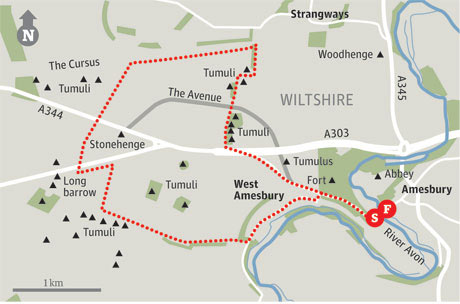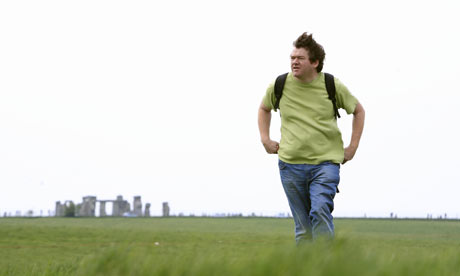Where time stops: the National Trust protected fields around Stonehenge .
Walk in a nutshell This is a walk steeped in history that takes you through sweeping National Trust-protected downland, past a number of exceptional prehistoric sites and alongside the world-famous
Stonehenge.
Walk ID 4755
- Classification Moderate
- Distance 11.3km (7 miles)
- Typical duration 3 hours 30 minutes
- Height gain 146m
- Starting point Parish church of St Mary and St Melor, Amesbury
- OS grid reference SU152413 (Explorer map 130)
Why it's special The walk starts in the town of Amesbury, said to be where Arthur's queen Guinevere ended her days, and leads you through picturesque countryside littered with grassy ridges and mounds that are actually ancient burial chambers and mysterious earthworks. You'll pass through the King Barrows, a collection of round and long burial mounds situated on a prominent ridge and divided into two groups by what's known as the Stonehenge Avenue. By step 6 of the walk you'll be in the centre of the Cursus, a massive earthwork 3km long and 100m wide that's aligned with the equinox sunrise and is several hundred years older than the earliest phase of Stonehenge. Towards the end of the route you'll pass the Normanton Down Barrows, a cemetery of round burial mounds dating from 2600BC to 1600BC with a clear line of site to Stonehenge about a kilometre away.
Keep your eyes peeled for The great bustard, extinct in the British Isles since 1832 and reintroduced to Salisbury Plain in 2004. The males have a wingspan of 2.5 metres.
But bear in mind Access into the stone circle at Stonehenge is only possible if you book and pay in advance, and happens outside normal visiting hours.
Recover afterwards Spitting distance from the end of the walk is the Antrobus Arms hotel, where you can grab a doorstop sandwich in the bar or fill up at the Sunday carvery.
antrobusarmshotel.co.uk
If it's tipping down Head 30km west to Longleat Safari Park. The lions and tigers may be soaking wet but you'll be nice and dry in the car. Or give up on the outside all together and explore the nooks and crannies of the house.
longleat.co.uk
How to get there
By car Amesbury is on the A345, 8km north of Salisbury. There is a small public car park near the parish church.
By public transport Buses run to Amesbury from Salisbury train station and take about 15 minutes.
1. With the parish church of St Mary and St Melor on the right, walk towards the bridge over the river Avon, then on a little further.
2. Round a bend, go along Stonehenge Road on a pavement passing Park Farm, then beside a dual carriageway (still on a pavement) for a short distance. Pass the thatched cottages and cross the road with care.
3. Take a footpath through a walkers' gate into a National Trust area where the New King Barrows stand on the right.
4. Turn left on a track signed to Cursus and Larkhill and walk beside a wooded area to a corner.
5. Turn left and take the stile ahead on a National Trust-permitted path to follow a fenceline in pastures. Cross a stile, then another, before bearing slightly left to head for a stile in the distance.
6. Climb over it and turn left, now at the centre of the Stonehenge Cursus. Walk on to pass the car park of Stonehenge, cross the road to continue on a track, Stonehenge just over to the left and the Normanton Barrows in view ahead.
7. Cross the road and take the track directly in front of you, walk along it for a short way and turn left at a signpost marked Amesbury across the field (at this point you are walking parallel with the A303). Cross this field to the next boundary and turn right.
8. Turn right on to a green track on a steady incline.
9. Turn left on a permissive path. Bear left from a marker to a corner of a fenceline.
10. Turn right to continue above deep swathes of landscape, following the fenceline beside a plantation for a short distance.
11. Turn right over a low fence and continue in the same direction downhill to a road.
12. Turn left along the narrow country road to pass a thatched house and go on into West Amesbury. Pass a large thatched cottage and West Amesbury House, then continue uphill to meet Stonehenge Road.
13. Turn right into Amesbury and retrace your steps to the start of the walk.
 Map of Amesbury walk Photograph: Guardian
Map of Amesbury walk Photograph: Guardian
Stonehenge Tour Guide
 TV archaeologist Julian Richards is to lead a series of walks around the World Heritage site of Avebury this summer and autumn.
TV archaeologist Julian Richards is to lead a series of walks around the World Heritage site of Avebury this summer and autumn.




